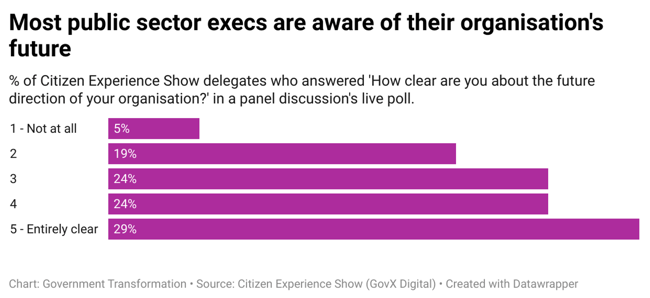Leading an effective government transformation strategy
What do you want your organisation to look like - and how do you get there? The Citizen Experience Show hosted a panel discussion with representatives from the National Audit Office, HMRC and Qualtrics to discuss their approaches to assessing the current state of their organisations, establishing a vision, getting buy-in and funding - and then executing successfully.
Barriers to government transformation
Yvonne Gallagher, Digital Director at the National Audit Office (NAO), has spent the last eight years reviewing the progress achieved by the UK government in digital transformation. In her view, the most valuable insight from this work is understanding the setting of an organisation.
“Transformation isn’t about spinning up new services in a greenfield environment,“ Gallagher said. “It's about understanding the existing estate and the existing business, it's about brownfield and legacy, and understanding how are we going to move from that to something more modern and transformative. And that is a really, really hard thing to do.”
In July 2021, NAO published a report on the challenges in implementing digital change in government. The audit focused on why public sector digital transformation projects are failing, leading to £13 billion spent on major programmes that did not succeed. 
“Some of these projects still go on after seven or eight years: it just flags up this challenge and how government is really trying hard to do this,” Gallagher continued, noting that through this report, NAO wanted to understand the systemic challenges preventing these digital programmes from succeeding.
Issues identified by the NAO audit included senior leadership’s lack of essential digital knowledge and skills, under-realistic ambitions, the way government engages with suppliers and major contracts, as well as problems around funding and legacy systems.
“All of these areas must get attention before these big programmes get kicked off,” Gallagher added. “The report was very well received, particularly by CIOs in government who are struggling to try and succeed in this transformation. There are a number of things around it that aren't in their control and that need to be addressed.”
The importance of strategic vision
When it comes to improving the chances of transformation success, Tim Lai, recent Director of Data Transformation at HMRC, prioritises three areas. The first one is strategy, an aspect he said is often undervalued and poorly understood.
“Sometimes the attitude is ‘just do it’ and that sort of impulsive instinct can lead to outstripping available capability and making things fragile and driving up the risk,” Lai told delegates. “That combination goes precisely against one of the perennial lessons of project management, which is prior preparation and planning to prevent poor performance. If you don't know what you're trying to achieve, and why and how it fits into everything, how the hell are you going to do it?”
HMRC’s recent enterprise level data strategy has provided a reference framework for both the fixed back and the build forward change across the department.
Strategising and planning should be accompanied by consultations, collaboration and co-creation with relevant partners that can produce insights and reconcile tensions. Lai added: “You improve coherence, get buy-in and build a common cause and shared vision amongst your stakeholders. It takes time and effort but it’s vital.”
The second focus area for Lai is scope management. Although selection of the aim is necessary, left alone is insufficient and needs to be complemented by its maintenance.
“Resisting scope creep, gold plating, but also protecting against scope erosion,” he said. “Maybe for budgetary reasons or presentational expediency we have often delivered the minimum viable product product but never gone beyond that because other stuff got in the way.”
Lastly, Lai recommended investing in the right capabilities to maximise the opportunities for transformation success. Drawing on the lessons from Jim Collins’ bestseller management book, Good to Great: Why Some Companies Make the Leap... and Others Don't, Lai said that having the right people at the right time may be the “the most important ingredient to success”.
“It’s a combination of capacity and competence, and investing early to avoid always playing catch-up,” Lai concluded.
The panel acknowledged the titanic task of government transformation and the need to use technology wisely and efficiently to avoid it being a burden rather than an enabler.
James Scutt, Principal Experience Management Catalyst at Qualtrics, said that IT should be providing insights to leaders rather than just being the source of great amounts of data. Understanding citizens and employees is also pivotal for any transformational activity.
“IT needs to enable the mindset, be that in employee experience or in customer-citizen experience,” Scutt said. “Your employees, your citizens, your customers will see you taking action on the things that your IT is unveiling for them. This is why employees and customers leave feedback: they expect action to be taken off the back of IT.”
Lai advised Citizen Experience Show delegates to always remember that technology is not an end in itself. Instead, technology should be business-led to help achieve the objectives of an organisation.
Tools need to be extendable and scalable so digital leaders can adapt them to continuously evolving scenarios.
“It seems to me that it is too often forgotten,” said Lai. “Technology can only ever be a way or a means to achieving that end. We must ask how technology can help rather than coming with a bright, shiny new bit of kit and saying ‘what can we do with it’?
“Fit tools into the bigger picture but also be dispassionate about your choices so that you can achieve that optimal solution in the interests of the greater good, rather than just using your favourite tool which you've always used before.”
NAO’s Gallagher advised leaders to ensure that the risks and constraints of legacy services existing around people, processes and systems are well understood. In addition, she recommended digital executives to be more influential and avoid failing into the “order taker” mandate.
Gallagher concluded: “This is about making sure the business change is being done. It’s about reminding everyone that technology is an enabler and demand the right information that you need to do the right thing.”
The panel discussion was supported by experience management experts Qualtrics. Catch up with the recording of this session here.






